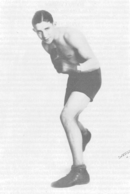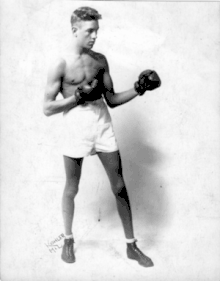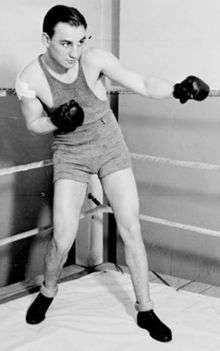Mushy Callahan
Mushy Callahan (November 3, 1904 – June 18, 1986) was the ring name of Vincent Morris Scheer, a Los Angeles-based boxing champion in the newly created World Light Welterweight Division for five years from 1926 to 1930. The championship was formerly referred to as the World SuperLightweight Title. After his retirement from boxing in 1932, Callahan refereed hundreds of matches, and had a thirty-year career taking small roles in movies, most with boxing themes, as well as working as a stuntman and boxing adviser on movie sets.
| Mushy Callahan | |
|---|---|
 Young Mushy Callahan | |
| Statistics | |
| Real name | Vincent Morris Scheer |
| Nickname(s) | The Fighting Newsboy |
| Weight(s) | Welterweight |
| Height | 5 ft 7.5 in (1.71 m) |
| Reach | 70 in (178 cm) |
| Nationality | |
| Born | November 3, 1904 New York City, New York |
| Died | June 18, 1986 (aged 81) Los Angeles, California |
| Stance | Orthodox |
| Boxing record | |
| Total fights | 67 |
| Wins | 48 |
| Wins by KO | 21 |
| Losses | 16 |
| Draws | 3 |
| No contests | 0 |
Early life and start in boxing
Callahan was born Vincent Morris Scheer, on November 3, 1905, in Manhattan's Lower East Side. His father was a produce merchant. He took the ring name of Mushy Callahan, discarding his more ethnic-sounding name, as most Jewish boxers did at the turn of the century. He was nicknamed Mushy from his Hebrew name Moishe, or Moses. According to Callahan, he took his last name from an Irish fight promoter at his Newsboy's boxing club.[1]
Callahan was a great counter puncher and possessed a fine defense. Though he could take a punch, his decline might be explained by the abdominal injuries he received in his July 27, 1927, bout with Sergent Sammy Baker which he lost in a ninth-round TKO. Callahan never fully recovered. He suffered from injuries to his hands as well early in his career.[1]
His family moved to the heavily Jewish neighborhood of Boyle Heights District in Los Angeles from New York when he was two. He was into amateur boxing by ten, and when he finally started professional boxing in 1924, four rounds were the limit in California, so his progress in gaining experience was limited.[2]
In 1925, when ten round fights were legalized in California, Callahan ran through a number of opponents including Russel LeRoy, and Pal Moran, knocking both out in three rounds. He also fought Red Herring, and Spug Myers. He defeated Ace Hudkins in ten rounds on November 14, 1925 in their second meeting in Vernon California, despite having broken bones in both hands. Callahan fought Hudkins to a draw in their first meeting on September 16, 1925, in Olympic Stadium in Los Angeles.[1][2]
Two months before winning the Light Welterweight Championship, Callahan was defeated in an upset by Pacific Coast Lightweight Champion Jack Silver at Ewing Field in San Francisco on July 25, 1926.
Light Welterweight crown and later boxing career

On September 21, 1926, Callahan fought Pinky Mitchell for Mitchell's World Light Welterweight crown. Mitchell was the first champion Light Welterweight, a class created in 1922. At the time of the fight, he had held it almost continuously from its inception in 1922 until his fight with Callahan. At the time the two boxers met, few recognized the legitimacy of a championship in this weight class. Nevertheless, Callahan beat Mitchell over ten rounds in Vernon, California and won the title.[3]
Callahan said in an interview of his subsequent title bout with Andy Di Vodi, "My biggest thrill came when I fought Andy Di Vodi in Madison Square Garden on March 14, 1927. The New York papers were full of Di Vodi...I knocked him out in the second round." Callahan defended his title again in 1927 against Spug Myers in Chicago, and on May 28, 1929, against Fred Mahan in Los Angeles. In the Andy Divodi win on March 14, 1927, NBA recognized the bout as being for the World SuperLightweight title. This was also the title recognized by the NBA in Callahan's winning ten round points decision against Spug Myers on May 31, 1927, in Wrigley Field in Chicago.[1][2]

Callahan fought a variety of non-title fights from 1927 to 1929. He fought 1925 NYSAC Lightweight Champion Jimmy Goodrich, in Vernon, California, in April and May 1926, winning in each ten round bout. One notable loss was his ten-round bout with Olympic Champion Jackie Fields on November 22, 1927 at Olympic Auditorium in Los Angeles. Some boxing writers attribute the Jackie Fields loss to the abdominal injuries he sustained in his bout with Sergent Sammy Baker four months earlier on July 27.
Of his March 28, 1928 ten round win over Dick Hoppe of Glendale, the Montreal Gazette wrote, that he had won "in the opinion of ring siders seven of the ten rounds." He had previously lost to Hoppe in ten rounds on November 10, in Legion Stadium. Hoppe was not the quality of competition he would later face in Jackie Berg.[1][4]
On July 24, 1929 Callahan first fought British boxer Jack "Kid" Berg, in a non-title fight. The ten round unanimous decision in favor of Berg at Ebbets Field in Brooklyn, New York, did not bode well for Callahan's chances in a title match with Berg. On February 18, 1930, Callahan put his title on the line against Jack "Kid" Berg again in Royal Albert Hall in London, England. Berg knocked him out in ten of fifteen rounds to take the title for his own. He held it for the remainder of the year. There is some dispute as to whether the Light Welterweight title was actually on the line in this fight. The National Boxing Association (NBA) had stripped Callahan of its version of the Light Welterweight title before the Berg fight. Furthermore, at the time of the Berg fight, Britain did not recognize the light welterweight division. The New York State Athletic Commission recognized the Berg–Callahan fight as being for the Light Welterweight title, however, and Berg won NBA recognition in 1931.[2]
Retirement from boxing and movie career
Callahan retired from professional boxing around 1932. Shortly after his last fight he began to referee boxing matches, working over four hundred between December 1932, until November 1960. He stayed close to the Los Angeles area as a referee, so he could pursue his career in the movie industry during this period.[5] After gaining a decade of experience as a referee, Callahan simultaneously worked as a boxing judge for over 100 fights mostly in the Los Angeles area, including four state championships, between 1941 and 1960.[6]
On October 9, 1937 Callahan was scheduled to box in a benefit exhibition at Legion Stadium in Los Angeles for Wad Wadheim, a fight promoter who had suffered a stroke. Among the fifty or so boxers that participated were triple World Champion Henry Armstrong, Callahan's opponents Jackie Fields, Ace Hudkins, and Jack Silver as well as Young Jack Thompson, Abe 'The Newsboy" Hollandersky, Fidel La Barba, ex-Middleweight champion Al McCoy, Jim Jeffries, and Maxie Rosenbloom.[7]
Callahan worked in the movie business in his boxing retirement. He did stunts for at least four movies in which he did not appear, and worked on the crew, often as a technical adviser for at least ten movies, many with boxing themes. The boxing movies in which he acted as an adviser include Paramount Picture's 1940 Golden Gloves, Warner Brother's 1942 Gentleman Jim in which he did fight choreography, Warner Brother's 1948 Whiplash, Columbia Picture's Corporation, 1948 Leather Gloves, Ventura Picture's 1957 The Crooked Circle, and the more widely seen contemporary Twentieth Century Fox's 1970 The Great White Hope with James Earl Jones.
He appeared in the following movies:
- Paramount Picture's, 1932 Madison Square Garden, in which Callahan appeared in uncredited role as Kid McClune, with appearances by boxing writers Grantland Rice and Boxing Hall of Fame writer Damon Runyon as themselves.
- Warner Brother's black and white 1934 boxing movie, The Personality Kid, in which Callahan had uncredited role as Biff Sullivan
- Warner Brother's 1935 boxing movie, The Irish in Us, in which Callahan acted as himself in the role of a referee. Other boxers in the movie included Billy Coe as himself and Sailor Vincent.
- Warner Brother's 1937 boxing movie, Kid Galahad, in which Callahan appeared as boxer, and worked as boxing trainer and adviser
- Warner Brother's 1939 They Made Me a Criminal, with John Garfield as accused boxer, in which Callahan has uncredited role as Schwimmer
- Twentieth Century Fox's, 1949 crime move with Edward G. Robinson, House of Strangers, in which Callahan has uncredited role as referee
- Universal International Picture's 1951 Ironman, boxing movie with Cole Mason, and Rock Hudson, in which Callahan appears as referee at downtown arena
- Warner Brother's, 1952 Stop, You're Killing Me, about a beer vendor, based on a play by Boxing Hall of Fame sports writer, author, and playwright, Damon Runyon, in which Callahan appeared as "No Nose"
- Paramount Picture's 1953 The War of the Worlds, with Gene Barry, in which Callahan appeared as Burning Soldier at Pit
- Columbia Picture's Corporation, 1954 The Bamboo Prison, in which Callahan appeared as a Prisoner of War
- Universal International Picture's, 1956 World in My Corner, boxing movie with Audie Murphey as lead, in which Callahan appeared as a referee
- Paramount Picture's 1956 boxing movie with John Derek and Paul Douglas, The Leather Saint, in which Callahan appears as referee
- MGM's 1957 Disigning Woman, with Gregory Peck as a sportswriter, in which Callahan appears as referee
- Walt Disney's 1959 The Big Fisherman, about the life of Peter, in which Callahan appears in a minor uncredited role
- Edward Small Productions, United Artists, 1960, Vice Raid, in which Callahan appears as Mushy the masseur
- Norma Pictures, 1962 Birdman of Alcatraz with Bert Lancaster, in which Callahan appeared as an uncredited inmate
- Mirisch Corporation's 1962 Kid Galahad, Elvis Presley movie, in which Callahan appeared as Romero, fight referee
Callahan also appeared in several television series. He played a referee in three episodes of Fireside Theater, Neutral Corner in 1951, Fight Night in 1954 and Cheese Champion in 1955. He played a referee in the 1960 The Gladiator's episode of Mr. Lucky. He also played a referee in the 1961 "Comeback" episode of Cain's Hundred. Finally in 1962, he played a referee in the TV series Route 66, "Feat of Strength".[8]
Honors
He was inducted into the World Boxing Hall of Fame in 1989.
See also
- List of light welterweight boxing champions
- List of select Jewish boxers
References
- The Jewish Boxer's Hall of Fame, Blady, Ken, (1988) Shapolsky Publishers, Inc., New York, NY, pgs.169-173
- "Mushy Callahan". BoxRec. Retrieved 5 May 2015.
- "Mushy Callahan - Lineal Junior Welterweight Champion". The Cyber Boxing Zone Encyclopedia.
- "Callahan Won", The Montreal Gazette, pg. 16, Montreal, Canada, 29 March 1928.
- "Mushy Callahan Referee Record". BoxRec. Retrieved 2 April 2015.
- "Mushy Callahan Judging Record". BoxRec. Retrieved 5 May 2015.
- "Wadham's Benefit Tonight", Los Angeles Times, p. A-10, Los Angeles, 9 October 1937.
- "IMDB Filmography of Mushy Callahan". IMDb. Retrieved 5 May 2015.
External links
- Boxing record for Mushy Callahan from BoxRec
- "IMDB Filmography of Mushy Callahan". IMDb. Retrieved 5 May 2015.
- Mushy Callahan - CBZ Profile
| Achievements | ||
|---|---|---|
| Preceded by Pinky Mitchell |
World Light Welterweight Champion September 21, 1926 – February 18, 1930 |
Succeeded by Jackie "Kid" Berg |